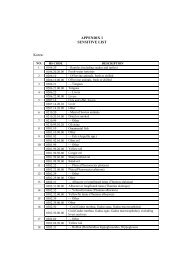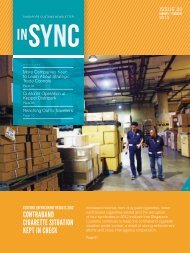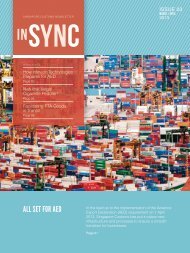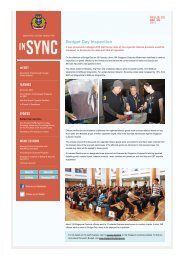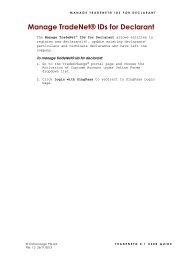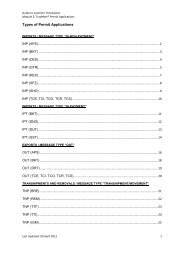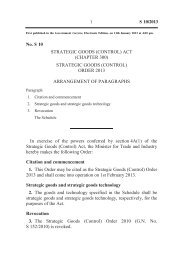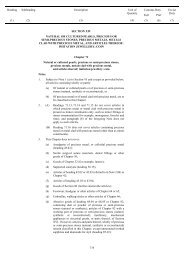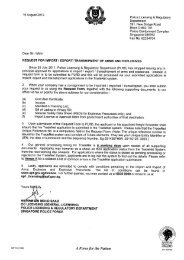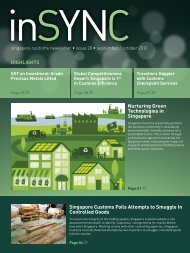Download PDF - Singapore Customs
Download PDF - Singapore Customs
Download PDF - Singapore Customs
Create successful ePaper yourself
Turn your PDF publications into a flip-book with our unique Google optimized e-Paper software.
FEATURES 07<br />
CUSTOM HOUSE<br />
THROUGH THE YEARS<br />
Built between 1930 and 1933 by<br />
the Public Works Department<br />
(PWD), the style of Custom House is<br />
representative of the works of PWD<br />
Chief Architect Frank Dorrington Ward,<br />
who also designed the old Supreme<br />
Court, the Hill Street Police Station<br />
(the current Ministry of Information,<br />
Communications and the Arts<br />
Building) and the old Traffic Police<br />
Headquarters Building (today’s Red<br />
Dot Museum).<br />
Like many buildings commissioned<br />
by the PWD to house administrative<br />
offices, Custom House was meant<br />
to serve as the headquarters for<br />
<strong>Singapore</strong> <strong>Customs</strong>, known for<br />
the most part back then as The<br />
Department of <strong>Customs</strong> and Excise.<br />
It did so for 57 years, from June 1932<br />
to August 1989. Other offices that<br />
shared the building include the Film<br />
Censor’s Office and the Maxwell Road<br />
Post Office.<br />
Custom House in the 1970s.<br />
Photo: Urban Redevelopment Authority<br />
During the Second World War in 1941,<br />
expatriate customs officers fleeing<br />
Malaya and their families sought refuge<br />
on the ground floor of Custom House.<br />
The building also sheltered Australian<br />
soldiers who had been rescued at sea<br />
after being attacked by Japanese forces.<br />
In 1989, when the <strong>Customs</strong> headquarters<br />
relocated to the then World Trade Centre<br />
at Maritime Square, Custom House was<br />
re-designed for commercial use and<br />
renamed the White House.<br />
The building today.<br />
Photo: Maxwell Chambers<br />
In recognition of its architectural and<br />
historical contribution to the area, the<br />
building was granted conservation status<br />
by the Urban Redevelopment Authority<br />
in 2007.<br />
In 2010, the building was renamed<br />
once again as Maxwell Chambers<br />
and currently houses the world’s first<br />
integrated dispute resolution centre<br />
for international arbitration cases.<br />
MEMORIES OF CUSTOMS PAST<br />
“Officers sitting among piles and piles<br />
of manifests, checking through each<br />
one. Some even had to wear rubber<br />
thumbs to help with the flipping.”<br />
MS ONG WEE WEE<br />
Senior Compliance Officer<br />
“All procedures were done manually<br />
and traders had to visit us to submit<br />
their declarations over the counter.<br />
There was a lot of face-to-face<br />
interaction. It’s certainly a very<br />
different world today where we have<br />
automation with TradeNet.”<br />
MR LEE NEE CHIAT<br />
Deputy Head (Schemes & Licensing)<br />
“The roadside hawker push carts<br />
around Custom House that served<br />
very good food. And the antique lift<br />
in Custom House with its unique<br />
configuration of doors that opened on<br />
two sides.”<br />
MS KAREN WOON<br />
Deputy Human Resource Officer<br />
“We moved to World Trade Centre in<br />
August 1989. It was the Hungry Ghost<br />
month. Some said it was not a good<br />
month to shift but we had to. It was sad<br />
leaving my cramped and cosy old office.<br />
The antique furniture, the wood and<br />
glass ones, had to go. They were of<br />
a different era.”<br />
Mr Mohan Singh<br />
Deputy Head (Prosecution)<br />
Permits counter at Custom House in the 1980s, where<br />
traders submitted their trade declarations to <strong>Customs</strong><br />
for processing manually over the counter.



